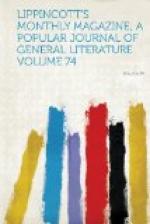“Yes,” he said: “this part of India is everywhere a land of beautiful tombs which enclose ugly memories. I recall one tomb, however, near which I have spent many hours of tranquil meditation, and which is at once lovely without and within: it is the tomb of the Muslim saint Allum Sayed at Baroda. It was built of stones taken from an old Jain temple whose ruins are still visible near by; and with a singular fitness, in view of its material, the Muslim architect has mingled his own style with the Hindu, so that an elegant union of the keen and naked Jain asceticism with the mellower and richer fancy of the luxurious Mohammedan has resulted in a perfect work of that art which makes death lovely by recalling its spiritual significance. Besides, a holy silence broods about the cactus and the euphorbian foliage, so that a word will send the paroquets, accustomed to such unbroken stillness, into hasty flights. The tomb proper is in the chamber at the centre, enclosed by delicately-trellised walls of stone. I can easily fancy that the soul of Allum Sayed is sitting by his grave, like a faithful dog loath to quit his dead master.
[Illustration: TOMB OF ALLUM SAYED.]
Jhansi was once in the enjoyment of a considerable trade. The caravans from the Deccan to Furruckabad and other places in the Douab were in the habit of stopping here, and there was much trafficking in the cloths of Chanderi and in bows, arrows and spears—the weapons of the Bundela tribes—which were here manufactured. Remnants of the wealth then acquired remain; and on the evening of the same day when we were wandering among the rajahs’ tombs we proceeded to the house of a rich friend of Bhima Gandharva’s, where we were to witness a nautch, or dance, executed by a wandering troop of Mewati bayaderes. We arrived about nine o’clock: a servant sprinkled us with rose-water, and we were ushered into a large saloon, where the bayaderes were seated with a couple of musicians, one of whom played the tam-tam and another a sort of violin. When the family of our host, together with a few friends, were seated at the end of the room opposite the bayaderes, the signal was given, and the music commenced with a soft and indescribably languorous air. One of the bayaderes rose with a lithe and supple movement of the body not comparable to anything save the slow separating of a white scud from the main cloud which one sees on a summer’s day high up in the cirrus regions. She was attired in a short jacket, a scarf, and a profusion of floating stuff that seemed at once to hide and expose. Presently I observed that her jewelry was glittering as it does not glitter when one is still, yet her feet were not moving. I also heard a gentle tinkling from her anklets and bracelets. On regarding her more steadily, I saw that her whole body was trembling in gentle and yet seemingly intense vibrations, and she maintained this singular agitation while she assumed an attitude of




